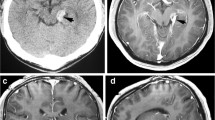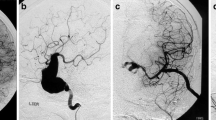Abstract
Giant serpentine and dolichoectatic aneurysms (GSDAs) are a small subgroup of intracranial aneurysms that often have poor clinical outcomes and are hardly to be treated by either conservative or endovascular management. We assessed seven patients who underwent internal maxillary artery bypass using radial artery graft interposition followed by parent artery occlusion to treat GSDAs. Intraoperative Doppler ultrasonography was used to assess the patency of the graft. CT angiogram or DSA were used postoperatively. The patients received follow-up after discharge and their neurological outcomes were measured using the Glasgow Outcome Score. Postoperative angiogram demonstrated that all the grafted conduits were patent, and the aneurysms were absent in two and collapsed or shrank in five of the patients. The rate of normal life or independent daily activities after internal maxillary artery bypass in the anterior and posterior GSDA patients was 66.7 and 75 %, respectively. One patient experienced postoperative frontal ischemia and was managed conservatively. His symptoms had completely resolved at discharge. No patient encountered perforator’s occlusion in the series. During 2.6 years follow-up, six patients experienced favorable outcomes. One patient died in the third year after discharge attribute to unrelated disease. Based on the mechanism of flow reversal, internal maxillary artery bypass with radial artery graft followed by patent artery occlusion is an effective, minimally invasive treatment modality for select patients with GSDAs.




Similar content being viewed by others
References
Abdulrauf SI, Sweeney JM, Mohan YS, Palejwala SK (2011) Short segment internal maxillary to middle cerebral bypass: a novel technique for extracranial-to-intracranial bypass. Neurosurgery 68:804–809
Almefty K, Spetzler RF (2014) Management of giant internal carotid artery aneurysms. World Neurosurg 82:40–42
Ament PS, Heros RC (2014) Interposition grafts and aneurysms. World Neurosurg 83:142–144
Amin-Hanjani S, Alaraj A, Charbel FT (2010) Flow replacement bypass for aneurysms: decision-making using intraoperative blood flow measurements. Acta Neurochir 152:1021–1032
Amin-Hanjani S, Chen PR, Chang SW, Spetzler RF (2006) Long-term follow-up of giant serpentine MCA aneurysm treated with EC–IC bypass and proximal occlusion. Acta Neurochir 148:227–228
Amin-Hanjani S, Du X, Mlinarevich N, Meglio G, Zhao M, Charbel FT (2005) The cut flow index: an intraoperative predictor of the success of extracranial-intracranial bypass for occlusive cerebrovascular disease. Neurosurgery 56:75–85
Anson JA, Lawton MT, Spetzler RF (1996) Characteristics and surgical treatment of dolichoectatic and fusiform aneurysms. J Neurosurg 84:185–193
Büyükmumcu M, Üstün ME, Şeker M, Karabulut AK, Uysal ÝÝ (2003) Maxillary-to-petrous internal carotid artery bypass: an anatomical feasibility study. Surg Radiol Anat 25:368–371
Christiano LD, GuptaG PCJ, Gandhi CD (2009) Giant serpentine aneurysms. Neurosurg Focus 26(5):E5
Dumont TM, Levy EI, Siddiqui AH, Snyder KV, Hopkins LN 3rd (2014) Endovascular treatment of giant intracranial aneurysms: a work in progress. World Neurosurg 81:671–675
Eller JL, Sasaki-Adams D, Sweeney JM, Abdulrauf SI (2012) Localization of the internal maxillary artery for extracranial-to-intracranial bypass through the middle cranial fossa: a cadaveric study. J Neuro Surg Part B: Skull Base 73(1):48–53
Fanning NF, Kelleher MO, Ryder DQ (2003) The pretzel sign: angiographic pattern of tortuous intra-aneurysmal blood flow in a giant serpentine aneurysm. Br J Neurosurg 17:67–71
Feng X, Lawton MT, Rincon-Torroella J, El-Sayed IH, Meybodi AT, Benet A (2016) The lateral triangle of the middle fossa: surgical anatomy and a novel technique for transcranial exposure of the internal maxillary artery. Oper Neurosurg 12:106–111
Flemming KD, Wiebers DO, Brown RD Jr, Link MJ, Huston J III, McClelland RL et al (2005) The natural history of radiographically defined vertebrobasilar nonsaccular intracranial aneurysms. Cerebrovasc Dis 20:270–279
Haddad GF, Haddad FS (1988) Cerebral giant serpentine aneurysm: case report and review of literature. Neurosurgery 23:92–97
Kalani MY, Zabramski JM, Nakaji P, Spetzler RF (2014) Twenty-year follow-up of flow reversal and revascularization for a giant serpentine basilar artery aneurysm. Oper Neurosurg 10:E493–E497
Karabulut AK, Ustün ME, Uysal II, Salbacak A (2001) Saphenous vein graft for bypass of the maxillary to supraclinoid internal carotid artery: an anatomical short study. Ann Vasc Surg 15:548–552
Kumabe T, Kaneko U, Ishibashi T, Kaneko K, Uchigasaki S (1990) Two cases of giant serpentine aneurysm. Neurosurgery 26:1027–1033
Ma L, Ren HC, Huang Y (2015) Bypass of the maxillary artery to proximal middle cerebral artery. J Craniofac Surg 26:544–547
Maruya J, Nishimaki K, Minakawa T (2011) Hyperperfusion syndrome after neck clip** of a ruptured aneurysm on a dolichoectatic middle cerebral artery. J Stroke Cerebrovasc Dis 20:260–263
Mawad ME, Klucznik RP (1995) Giant serpentine aneurysms: radiographic features and endovascular treatment. Am J Neuroradiol 16:1053–1060
Mohit AA, Sekhar LN, Natarajan SK, Britz GW, Ghodke B (2007) High-flow bypass graft in the management of complex intracranial aneurysms. Neurosurgery 60:105–123
Nossek E, Costantino PD, Eisenberg M, Dehdashti AR, Setton A, Chalif DJ, Ortiz RA, Langer DJ (2014) Internal maxillary artery-middle cerebral artery bypass: infratemporal approach for subcranial-intracranial (SC-IC) bypass. Neurosurgery 75:87–95
Patel DV, Sherman IC, Hemmati M, Ferguson RL (1981) Giant serpentine intracranial aneurysm. Surg Neurol 16:402–407
Segal HD, McLaurin RL (1977) Giant serpentine aneurysm: report of two cases. J Neurosurg 46:115–120
Sekhar LN, Duff JM, Kalavakonda C, Olding M (2001) Cerebral revascularization using radial artery grafts for the treatment of complex intracranial aneurysms: techniques and outcomes for 17 patients. Neurosurgery 49:646–659
Sekhar LN, Natara** SK, Ellenbogen RG, Ghodke B (2008) Cerebral revascularization for ischemia, aneurysms, and cranial base tumors. Neurosurgery 62:1373–1408
Shi XE, Qian H, Fang T, Zhang YL, Sun YM, Liu FJ (2015) Management of complex intracranial aneurysms with bypass surgery: a technique application and experience in 93 patients. Neurosurg Rev 38:109–120
Shi X, Qian H, KI KC, Zhang Y, Zhou Z, Sun Y (2011) Bypass of maxillary to proximal middle cerebral artery or proximal posterior cerebral artery with radial artery graft. Acta Neurochir 153:1649–1655
Suzuki S, Takahashi T, Ohkuma H, Shimizu T, Fujita S (1992) Management of giant serpentine aneurysms of the middle cerebral artery—review of literature and report of a case successfully treated by STA-MCA anastomosis only. Acta Neurochir 117:23–29
Ulku CH, Ustun ME, Buyukmumcu M, Cicekcibasi AE, Ziylan T (2004) Radial artery graft for bypass of the maxillary to proximal posterior cerebral artery: an anatomical and technical study. Acta Otolaryngol 124:858–862
Ustun ME, Buyukmumcu M, Ulku CH, Cicekcibasi AE, Arbag H (2004) Radial artery graft for bypass of the maxillary to proximal middle cerebral artery: an anatomic and technical study. Neurosurgery 54:667–671
Van Rooij WJ, Sluzewski M, Beute GN (2008) Endovascular treatment of giant serpentine aneurysms. Am J Neuroradiol 29:1418–1419
Vishteh AG, Spetzler RF (1999) Evolution of a dolichoectatic aneurysm into a giant serpentine aneurysm during long-term follow up. J Neurosurg 91:346
Vrionis FD, Cano WG, Heilman CB (1996) Microsurgical anatomy of the infratemporal fossa as viewed laterally and superiorly. Neurosurgery 39:777–786
Xu K, Yu T, Guo Y, Yu J (2016) Study and therapeutic progress on intracranial serpentine aneurysms. Int J Med Sci 13:432–439
Yu YL, Moseley IF, Pullicino P, McDonald WI (1982) The clinical picture of ectasia of the intracerebral arteries. J Neurol Neurosurg Psychiatry 45:29–36
Zis P, Fragkis S, Lykouri M, Bageris I, Kolovos G, Angelidakis P et al (2015) From basilar artery dolichoectasia to basilar artery aneurysm: natural history in images. J Stroke Cerebrovasc Dis 24:e117–e119
Acknowledgments and funding information
Bei**g Municipal Natural Science Foundation (7161005, Dr. **ang’en Shi).
Science and Technology Commission Foundation of Bei**g (Z161100000516019, Dr. **ang’en Shi).
Author information
Authors and Affiliations
Corresponding author
Ethics declarations
Conflict of interest
The authors declare that they have no conflict of interests.
Rights and permissions
About this article
Cite this article
Wang, L., Shi, X. & Qian, H. Flow reversal bypass surgery: a treatment option for giant serpentine and dolichoectatic aneurysms—internal maxillary artery bypass with an interposed radial artery graft followed by parent artery occlusion. Neurosurg Rev 40, 319–328 (2017). https://doi.org/10.1007/s10143-016-0778-8
Received:
Revised:
Accepted:
Published:
Issue Date:
DOI: https://doi.org/10.1007/s10143-016-0778-8




